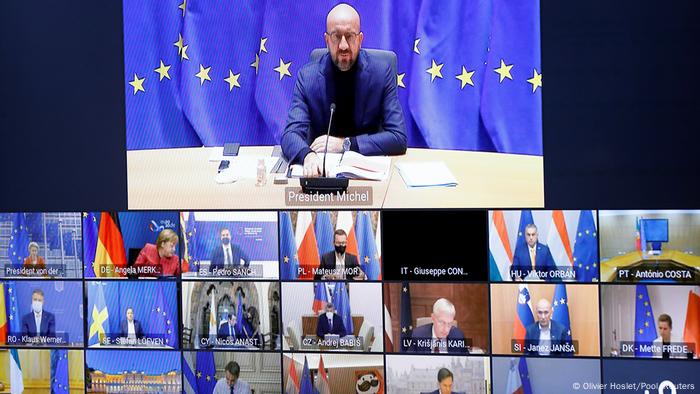A Dutch journalist took advantage of a security blunder to hack into a video call with EU defense ministers. "I'm sorry for interrupting your conference, I'll be leaving," the reporter told the EU's top diplomat.

EU meetings -like this leaders' conference - have been taking place in video conferences due to the coronavirus
EU defense ministers and the bloc's foreign policy chief Josep Borrell had a surprise during a supposedly confidential video conference on Friday when a reporter for Dutch broadcaster RTL Nieuws gained access to the call.
The reporter, Daniel Verlaan, used information from a Twitter post by Dutch Defense Minister Ank Bijleveld. The minister had published a photo of herself working from home while taking part in the conference. The post includes a photo of the minister's laptop screen with her EU counterparts visible. Another picture, which has since been removed, showed five digits of a six-digit pin needed to gain access to the call.
A Twitter user flagged the information to RTL Nieuws, prompting Verlaan to try hacking the meeting. In his own Twitter post, Verlaan said the code could be guessed "with a few tries."
What did Borrell say to the reporter?
The video published by the broadcaster shows EU's Josep Borrell asking "Who are you?" and noting the call has been "intercepted."
"Now I have to stop because we are working at a public square," Borrell continued before addressing the reporter again.
"How are you?" he asked.
"Hi, I'm fine, how are you," the journalist responded.
Borrell then asked if the reporter was aware that he was "jumping into a secret conference," as laughter is heard in the background.
"Yes, I'm sorry, I'm a journalist from the Netherlands," Verlaan replied. "I'm sorry for interrupting your conference. I'll be leaving here."
Borrell then said the breach was a criminal offense, "So you better shut off quickly," as the reporter replies with a "Yes. Bye, bye."
It was not immediately clear if Verlaan would face legal consequences.
What was the official reaction?
Dutch Prime Minister Mark Rutte has since reacted to the security blunder with a jab at his defense minister.
"This shows once again that ministers need to realize how careful you have to be with Twitter," Rutte said in the Hague.
An official with the Dutch Defense Ministry described the incident as a "stupid mistake."
Separately, an EU diplomatic source told the AFP news agency the meeting was cut short immediately after the reporter gained access.
"There may have been laughter, but the incident is considered as very serious," the official said.
dj/sms (AFP, dpa)







